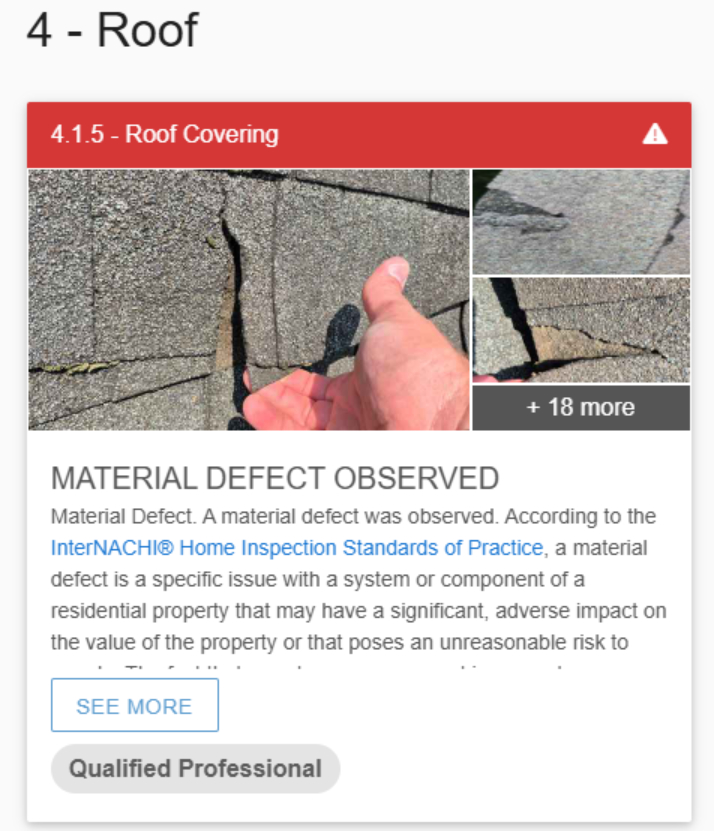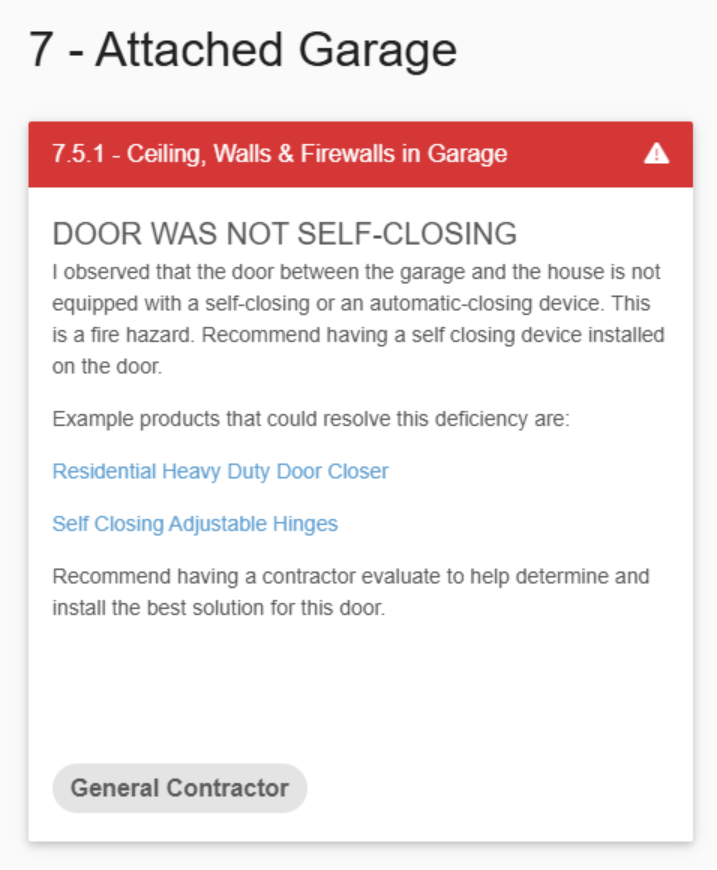This is part 4 of a deep dive series into our inspection reports. For this post, we’ll focus on the report defect category of ‘Major Defect’.
By: Sean Struckmeyer | Tech Inspect Home Services
To see more about the report in general, see Part 1 in the blog series.
Part 2 Covered Maintenance Items.
Part 3 Covered Repair/Replace Items.
What is a Major Concern Defect? Simply, any Safety Items, Structural issues, or material defects.
What is a material defect? InterNACHI defines it as follows in the Standards of Practice:
1.2. A material defect is a specific issue with a system or component of a residential property that may have a significant, adverse impact on the value of the property, or that poses an unreasonable risk to people. The fact that a system or component is near, at or beyond the end of its normal useful life is not, in itself, a material defect.
Still Confused? Don’t worry! We’ll elaborate a bit with a couple of examples, but first we need to highlight a paradox:
All Material Defects are reported as ‘Major Concerns’, but not all reported ‘Major Concerns’ are Material Defects.
Let’s Dig into that some more:
When our inspector finds a defect, we must ask a few questions to determine if that defect should be deemed to be material. Deemed is the action word. In the inspector’s opinion based on the visible facts. First the inspector must observe it as a defect and then determine (deem) that it is material.
What are some of the questions an inspector may use to deem a defect as material?
1) Does it pose an unreasonable risk to people?
2) Does it have an adverse effect on the value of the property?
Example of a Material Defect:
Here’s an Example of a Material Defect where the defects found on the roof were deemed material at the time of the inspection. In other words the condition of the roof was deemed material because, in the inspectors opinion it met the criteria of having an adverse effect on the value of the property. The example roof, had multiple significant issues with it and would likely need to be fully replaced (at a significant cost, thus having an adverse impact on the home’s value) in order to properly remediate all the issues that were discovered with this particular roof.
Material Defects will be ‘Red’ Cards in the report aligned to the major system (i.e. Roof) where it was observed and have significant documentation, the example below has 18 pictures and a complete narrative documenting the observed condition of the roof.

Just because a Roof has issues, does that make it a material Defect? No, just because we find a few defects on a roof specifically, does not automatically make it material (context on what it would take to resolve the issues are important), and just because a roof may be at the end of it’s serviceable life, does not make it material.
What should you do if the inspector highlights a Material Defect? If the inspector does highlight something material, then you need to pay extra attention to that defect and ask plenty of questions, to ensure you understand WHY it was deemed material and the impact it could have on the home if not corrected. Also, you need to ensure that that your realtor is aware of it. This could have signification implications on your negotiations and decision to complete the purchase of the home.
Additional Examples of what May be a Material Defect:
A Deck that is unsafe to stand on, this could be for a variety of reasons, maybe the support posts are rotten and it’s leaning, maybe it’s pulling away from the ledger board.
- If it’s not safe to stand on and it detracts from the home’s value, because it is no longer a functional feature but a safety hazard that will require time and money to replace, then it would be deemed a material defect.
Siding that appears to be asbestos and is damaged.
- Damaged asbestos siding poses a health risk
- To replace it, will require time and money as special protocols are required to dispose of it.
If a house has asbestos siding, does that make it material? No, Not necessarily, it depends on the condition (damaged, cracked or in good condition) of the siding. You will want to take into account that asbestos siding will incure additional disposal and replacement costs if it’s ever replaced or repaired.
All Material Defects are reported as ‘Major Concerns’, but not all reported ‘Major Concerns’ are Material Defects.
Remember, we said safety items are also considered major concerns.
What are some examples of safety items that we might flag?
- Busted up concrete on the sidewalk that poses a significant tripping hazard
- Entry door to the house from the attached garage not self-closing
- Lack of firewall between the garage and house
- Lack of smoke detectors
- An Active Gas leak
- Back drafting at a gas appliance
- CO buildup
- Broken Garage Door Spring
- Garage Door Did Not Auto Reverse
- Missing or Cracked Chimney Liner
- And more.
These are just some examples of things that the inspector may find and represent safety concerns.
Safety concerns should be prioritized, because they do pose a safety hazard.
For instance, the Garage Door Auto reverse not working, that’s device is important to prevent the garage door from closing when it encounters resistance, such as someone (like a child) stuck under it. Garage doors are very heavy, several hundred pounds, so if this important safety feature is not working, it needs to be corrected. This is a safety item, it may be a simple fix, but it needs to be fixed with the highest urgency.
Important: As a homeowner you should not immediately equate safety concerns with costly repairs. Context is everything.
Again, not all ‘Major Concerns’ are material. Material concerns have an adverse impact on the home and will probably take considerable resources to resolve. These are items that you need to be sure you fully understand by discussing with your inspector and agent.
So what are some examples of Safety related ‘Major Concerns’?
For Example: The entry door between the attached garage and the home not being self-closing? That’s a $9 door hinge from Home Depot. Yes, It’s safety issue and a ‘Major Concern’ that should be resolved before you move in, but it doesn’t cost a lot to fix it. A trip to the hardware store, a drill and a bit of effort to adjust it, and that ‘Major Concern’ can be taken care of. Below is an example of a defect card from a report for this very issue. Notice that in the card, we provide links to products that could resolve this issue, hinges and an automatic door closer.

Another Example: A gas leak at the water heater. A natural gas leak is very much a safety issue and a Major Concern. But the fix may be as simple as tightening the fitting half a turn to get a better seal. A simple fix does not detract from the concern. So, context and what it will or could take to fix things must be always kept in mind.
In Summary:
What should you do if you see a lot of ‘Major Concern’ on your Report? Breathe, read the report and ask your home inspector lots of questions. There may be issues that are easy to fix and there may be issues that make you decide to find another house. In that case, you’ll be very glad you had the inspection!
If the inspector can’t provide guidance on an issues, then consulting with a qualified professional from the list of contractors provided in your home inspection report, should be the next steps to gather as much information as possible before making a decision.
After reading the report, follow with your certified home inspector to ask questions, we are here to consult and support you throughout the home buying process.
